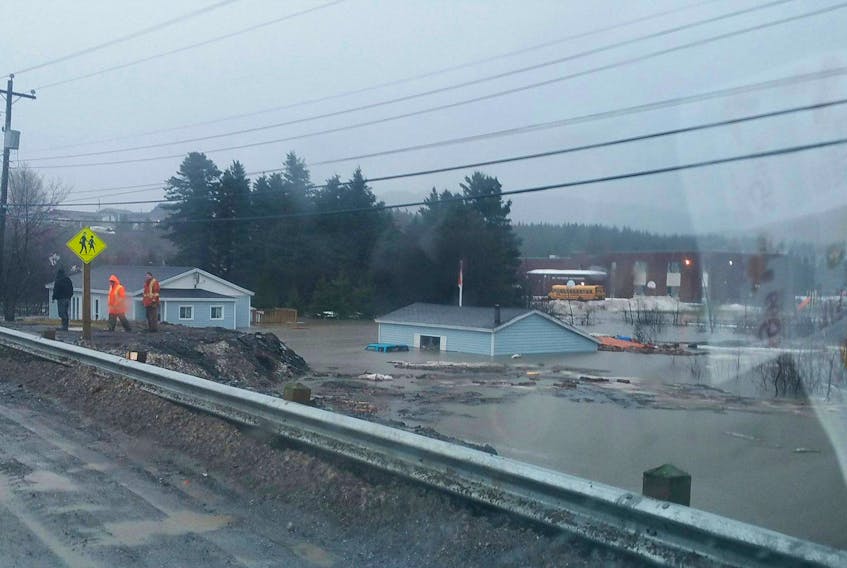The west coast of Newfoundland was hit hard by heavy rains and flooding over the weekend.
As a result, there was heavy damage to homes and infrastructure across the region and the provincial government has begun to process of assessing damage costs.
In a press release Tuesday, the government advised residents, not-for-profits organizations and communities that applications for the Newfoundland and Labrador Disaster Finanicial Assistance Program (weblink below).
Compensation for damages is based on a criteria for both federal and provincial disaster relief programs, while applications can be submitted by homeowners, small businesses, non-profit organizations and communities.
While the relief programs are there, residents are being asked to contact their insurance providers first.
Meanwhile, the Insurance Bureau of Canada has a phone line for insurance policy holders if they need information or advice. That number is 1-844-227-5422, ext. 228.
Additional information for the provincial assistance program is availble by calling 1-888-395-5611 or by emailing [email protected].
Weblink: gov.nl.ca/fes/faq/emergencymanagement.html.
Advice for Residents and Communities Affected by Flooding
General Advice
• Contact your insurance company immediately to determine if you have coverage. Follow any advice they provide.
• Ensure authorities have advised that it is safe to re-enter the home.
• If the main power switch was not turned off prior to flooding, do not re-enter the home until a qualified electrician has determined it is safe to do so.
• Use extreme caution when returning to the home after a flood.
• Do not use any appliances, heating, pressure, or sewage systems until electrical components have been thoroughly cleaned, dried, and inspected by a qualified electrician. Appliances that may have been flooded pose a risk of shock or fire when turned on.
• The main electrical panel must be cleaned, dried, and tested by a qualified electrician to ensure that it is safe.
• Depending on where residents live, the municipal or provincial inspection authority is responsible for the permitting process required before the electric utility can reconnect power to the home.
Ensuring Building Safety
• Make sure the building is structurally safe.
• Look for buckled walls or floors.
• Watch for holes in the floor, broken glass and other potentially dangerous debris.
Flood Water
• Flood water can be heavily contaminated with sewage and other pollutants. It can cause sickness and infections.
• If by colour, odour or taste you suspect that your drinking water has been contaminated, don't drink it.
• Household items that have been flood-damaged will have to be discarded according to local waste disposal regulations, but do not do so until such time as adjustors have had a chance to review the items. Please keep in a specific area on your property, covered with a tarp.
Documentation of Flood Damage
• Store all valuable papers that have been damaged in a freezer until they are needed (after the cleanup, consult a lawyer to determine whether flood-damaged documents, or just the information in them, must be retained).
• Record details of flood damage by photograph or video, if possible.
• Register the amount of damage to the home with both the insurance agent and local municipality immediately.
DRINKING WATER AND HOME HEATING FUEL
Flooding of Wells
• Assess the condition of the well. Ensure the ground surface around the well is intact and stable. Check to see if any electrical components or wires are visible, or if there is damage to the well casing.
• Mud, silt and other debris should be removed from the well casing, cap and all accessible components.
• Disinfect the well.
• After a contaminated well has been properly disinfected and the chlorine has been flushed out of the water system, the water should be tested to confirm that bacterial contamination has been removed.
• Until testing shows that the water is free of bacterial contamination, continue to use disinfected or boiled water.
For more information on flooding and well water safety, please visit www.mae.gov.nl.ca/waterres/quality/drinkingwater/index.html
Oil Tank Leaks
• Stop any leak and clean up the impacted area, including taking all reasonable steps to recover escaped fuel, and remove or treat contaminated soil located on the property. This should be done only when the site has been assessed and it is deemed safe to do so.
• Contact a heating oil provider, heating contractor or a Licensed Inspector for assistance.
• Contact the Spill Report Line at 1-800-563-9089.
• Have any leak temporarily sealed, if possible.
• Remove any heating oil from the leaking tank.
For more information on measures to deal with damaged oil tanks and fuel leaks, visit www.mae.gov.nl.ca/env_protection/petroleum/pdf/oil_tank_damage.pdf
Mould Abatement
The following are guidelines to use while dealing with mould:
• While cleaning up in a room where mould is present, people should wear a face mask and disposable gloves.
• Residents may need to have their home professionally cleaned by a company specializing in mould abatement. Home owners are reminded to contact their insurance company to check coverage.
• A cool, dry area minimizes mould growth.
• Alternatively, textiles, furs, paper and books can be frozen until they are treated.
• Wet mould will smear if wiped. Let it dry and, if possible, move the effected items outside to brush it off.
• Mould spores can also be destroyed by lightly misting the item with isopropanol (rubbing alcohol).
For carpets and furniture:
• Carpets soaked with sewage must be discarded.
• Remove residual mud and soil from furniture, appliances, and other affected items.
• If items are just damp, let the mud dry and then brush it off.
• To test if material is dry, tape clear food wrap to the surface of the item. If the covered section turns darker than the surrounding material, it is still damp. Dry until this no longer occurs.
• For upholstered furniture, residents should consult a professional to see what can be salvaged. In the meantime, remove cushions and dry separately. Do not remove upholstery. Raise furniture on blocks and place fans underneath.
• Wooden furniture: remove drawers and open doors. Do not dry quickly or splitting may occur.
Source: Government of Newfoundland and Labrador









